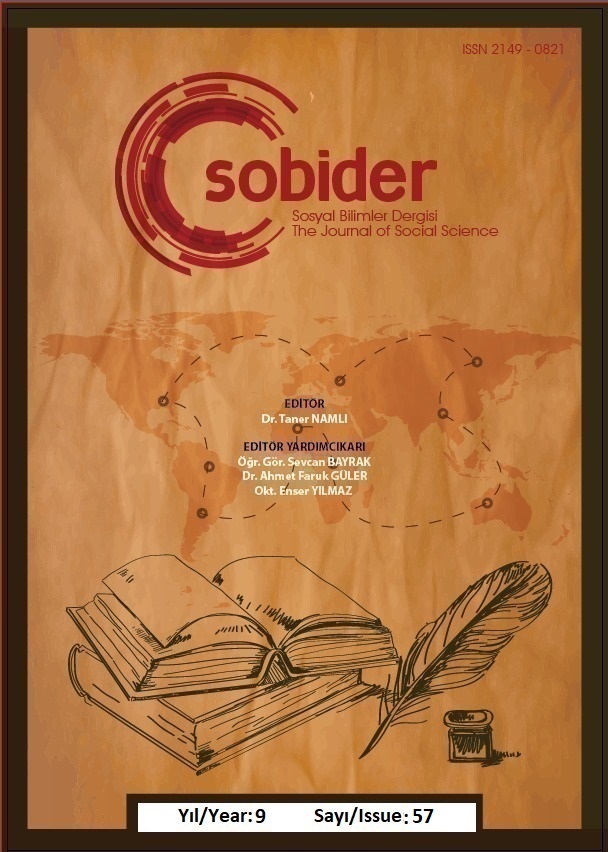Author :
Abstract
En az iki metin arasındaki alışverişi inceleyen metinlerarasılık ile iki sanatsal gösterge dizgesinin arasındaki alışverişi inceleyen göstergelerarasılık kavramlarının modernizmden postmodernizme geçiş döneminde sık sık işlendiği görülmektedir. Sergei Parajanov da aynı dönemde sinema ve resim ilişkisinin birlikteliğini işlediği filmleriyle incelediğimiz kavramlara ışık tutmaktadır. Filmlerinde olay örgüsünün içerisine resim sanatını da katan Parajanov, hapiste kaldığı dönem uğraştığı kolaj sanatının bir benzerini de sinemasında uygulamaktadır. Filmin konu bütünlüğü içerisinde sahne aralarına yerleştirdiği ikona, fresk, minyatür ve duvar resmi onun sinematografik anlatımını güçlendiren sanatsal biçimlerdir. Çerçevesini bir ressamın titizliği ve ustalığında düzenleyen Parajanov yaptığı filmlerde, olayların akışında ve sahne arası geçişlerde bir sonraki sahnede ne ile karşılaşacağımızı göstermede ipuçları sağlayan imgelerle sinema ve resim ilişkisini güçlü bir şekilde kullanan yönetmenlerden bir tanesidir. Bu çalışmanın amacı, Sergei Parajanov’un 1962 sonrası çektiği Narın Rengi ve Aşık Garip filmlerinde göstergelerarasılık bağlamında sinema ve resim ilişkisini ortaya koymaktır.
Keywords
Abstract
In the transition period from modernism to postmodernism, the concepts of intertextuality, which examines the exchange that occur between at least two texts, and intersemiotics, which examines the exchange between two artistic indicator systems, are frequently discussed. Sergei Parajanov sheds light on the concepts we examine with his films of the same period, in which he deals with the relationship between cinema and painting. Parajanov adds the art of painting to the plot of his films and applies a similar art of collage, which he was interested in while in prison, in his cinema. The icons, frescoes, miniatures and wall paintings he placed between the scenes are artistic forms that strengthen the cinematographic expression of the film within its thematic integrity. Parajanov arranges the frame with the meticulousness and mastery of a painter and is one of the directors who strongly uses the relationship between cinema and painting, with images that provide clues about what we will encounter in the next scene in the flow of events and transitions between scenes. This study aims to reveal the relationship between cinema and painting in the context of intersemiotics, Sergei Parajanov's post-1962 films The Color of Pomegranate and Aşık Garip.
Keywords
- Aktulum, K. (2018). Sinema ve Metinlerarasılık, Konya: Çizgi kitabevi.
- Aydın, D., U. (2017). Benzer ve Farklı Yönleriyle Resim ve Sinema İlişkisi. The Journal of Academic Social Science Studies, 56, 393-408. http://dx.doi.org/10.9761/JASSS7037
- Bukareva, V., (2020). Değişen Siyasal Yapı Bağlamında Sovyet Sinemasında Komedi Türünün Dönüşümü. Mersin Üniversitesi Sosyal Bilimler Enstitüsü e-Dergisi, 4(1), 8-28. https://dergipark.org.tr/tr/download/article-file/1130990
- Büyükdüvenci S., Öztürk, S. R. (1997). Postmodernizm ve Sinema. S. Büyükdüvenci, S. R. Öztürk içinde, Postmodernizm ve Sinema (s. 13-30). Ankara: Bilim ve Sanat Yayınları Ark.
- Çanğa, E., Uğur, U. (2015). Sinema Resim İlişkisi Bağlamında Bunuel’in Sürreal Sineması ve ‘Bir Endülüs Köpeği’ Filmi. Ordu Üniversitesi Sosyal Bilimler Enstitüsü Sosyal Bilimler Araştırmaları Dergisi, 5(13), 137-153.
- Efird, R., (2018). Sergei Parajanov’s Differential Cinema. Virginia Polytechnic Institute and State Unıversity, 22(3),465-483. doi: 10.3366/film.2018.0090
- Oeler, K., (2006). A Collective Interior Monologue: Sergei Parajanov and Eisenstein's Joyce- Inspired Vision of Cinema. The Modern Language Review, 101(2):472-487. https://doi.org/10.2307/20466795
- Stam, R., Burgonye, R., Flitterman-Lewis S. (2019). Sinemasal Göstergebilim Sözlüğü. Simten Gündeş (Çev.). İstanbul: es yayınları.
- Uğur, U. (2020). Metinlerarasılık Bağlamında Sinema Resim İlişkisi. Akademik Sosyal Araştırmalar Dergisi. 105, 87-107. http://dx.doi.org/10.29228/ASOS.42951
- Yalın, T. (2020). Bir Yönetmenin Müzesi: Lars Von Trier Sinemasında Resim-Sinema İlişkisi. Yayımlanmamış Yüksek Lisans Tezi. Yaşar Üniversitesi Lisansüstü Eğitim Enstitüsü, İzmir.
- Görsel 1: https://hayastandans.wordpress.com/2016/12/21/parajanovun-renkleri/ (Erişim Tarihi: 04.02.2022)
- Görsel 2: https://artsandculture.google.com/asset/henry-ford-hospital/kgHTa- 02kVhHJA?hl=tr&ms=%7B%22x%22%3A0.5%2C%22y%22%3A0.5%2C%22z%22% 3A8.873974018180236%2C%22size%22%3A%7B%22width%22%3A1.69546053215 70304%2C%22height%22%3A1.2375000000000005%7D%7D (Erişim Tarihi: 20.01.2022)
- Görsel 5: http://www.seffafgazete.com/haberler/gundem/35930/ayasofyada-ikona-ve-freskler- karartilacak-?puan=2 (Erişim Tarihi: 29.12.2021)
- Görsel 7: https://tr.wikipedia.org/wiki/Kilise_Babalar%C4%B1 (Erişim Tarihi: 23.12.2021)
- Görsel 13: https://ozhanozturk.com/2020/06/13/kralice-tamar-gurcistanin-altin-cagi/ ve https://tr.wikipedia.org/wiki/Tamar (Erişim Tarihi 25.12.2021)
- Görsel 16: http://www.tirendaz.com/tr/?page_id=2846 (Erişim Tarihi 04.02.2022)
- Görsel 18: http://www.tirendaz.com/tr/?page_id=2846 (Erişim Tarihi 05.02.2022)





